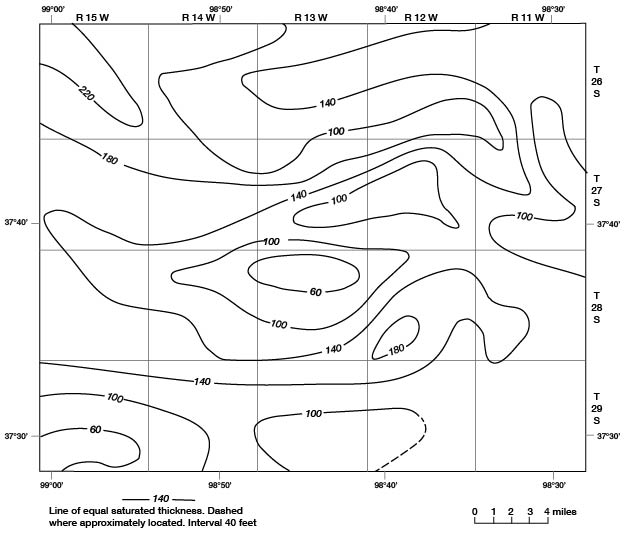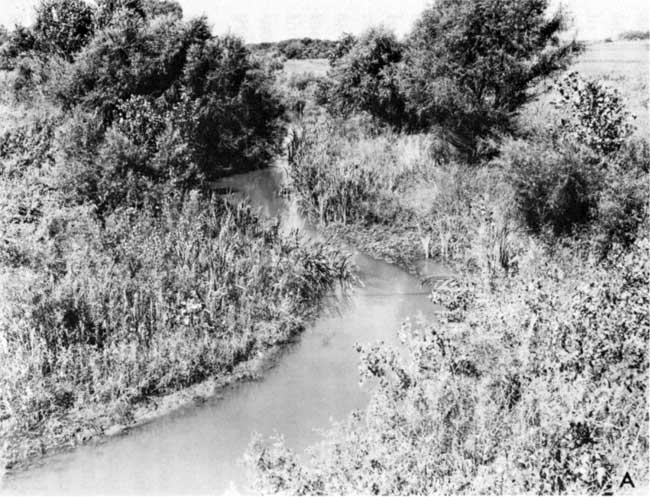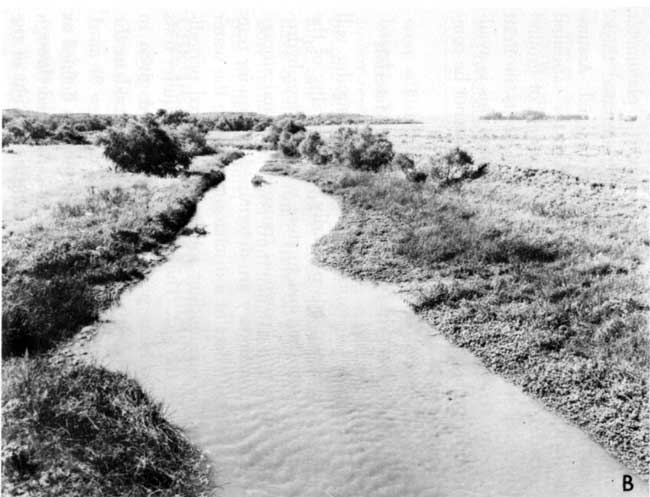Prev Page--Geology || Next Page--Quality and Summary
Ground Water
Fresh ground water that is chemically suitable for the common uses occurs under three conditions in Pratt County--confined, unconfined, and perched (fig. 7). Confined ground water in the county is found in the South Fork Ninnescah Valley downstream from near Cairo where a clay lens occurs at depths from 10 to 20 feet below land surface. Ground water below the clay lens in this area is under hydraulic (artesian) pressure and wells at low altitudes near the stream will flow. The abandoned industrial well 27-11W-25cdb is a flowing artesian well. The surface defined by the levels to which water will rise or stand in tightly cased wells is the potentiometric surface.
Figure 7--Generalized occurrence and movement of water in east-central Pratt County. Arrows indicate direction of movement of water and water vapor.

Unconfined ground water is found in most of the wells in Pratt County. This water is under atmospheric pressure only and will not rise in wells above the level where it is first found. The upper surface of the unconfined ground water is the water table, which is a particular potentiometric surface.
Perched ground water also is unconfined, but is trapped above a relatively impermeable layer of clay or silt that lies in unsaturated deposits above the potentiometric surface in the area. Perched ground water generally is limited in areal extent; it was found in several test holes drilled in Pratt County as part of this study.
Potentiometric Surface and Movement of Ground Water
The potentiometric surface in Pratt County is constantly rising or falling in response to changes in the rate of recharge to and discharge from the aquifer. The configuration of the potentiometric surface in late spring and summer 1964 is shown by contours on plate 1. Any given contour connects points of equal altitude of the potentiometric surface. Ground-water movement is perpendicular to the contours in a down-slope direction. In Pratt County, the movement is generally eastward and the gradient is about 9 feet per mile. The rate of movement is slow; it ranges from less than 1 inch per day in silt and clay to several feet per day in well-sorted sand and gravel.
Recharge
Although the total amount of recharge to the ground-water reservoir in Pratt County is unknown, sources of recharge are (1) infiltration of part of the precipitation on the county, (2) movement of ground water into the county from adjacent areas to the west, (3) return of some of the ground water pumped for irrigation, and (4) upward leakage of saline water from Permian rocks. Recharge by seepage of streamflow through stream channels is considered to be negligible in Pratt County.
Precipitation
The annual precipitation in Pratt County averages about 933,000 acre-feet of water. From 5 to 10 percent of this annual average is estimated to recharge the ground-water reservoir in the county, with the higher percentage occurring in areas that are underlain by dune sand. Recharge from precipitation in Pratt County probably averages about 62,000 acre-feet of water annually.
Subsurface Inflow
The ground-water reservoir in Pratt County also is recharged by the movement of ground water into the county from adjacent areas to the west. The amount of subsurface inflow can be estimated using the formula Q = KIA, where:
Q = the quantity of water;
K = the hydraulic conductivity of the aquifer;
I = the hydraulic gradient;
A = the area through which the water moves.
The hydraulic conductivity, as determined from aquifer tests described elsewhere in this report, is about 134 feet per day. Contours of the potentiometric surface (pl. 1) show that the hydraulic gradient across the western boundary of the county is about 9 feet per mile. The cross-sectional area through which water moves across the western boundary of the county is about 19.5 million square feet, as determined from the saturated thickness shown on figure 8. Using these values and the equation above, the subsurface inflow to Pratt County is estimated to be about 38,000 acre-feet per year.
Figure 8--Saturated thickness of Pleistocene deposits, 1964.

Irrigation Return
Recharge to the ground-water reservoir in Pratt County from ground water withdrawn for irrigation is unknown. However, much of the irrigation in the county is by sprinkler systems. The percentage of the applied irrigation water that returns to the ground-water reservoir probably is similar to the percentage recharge from precipitation.
Saline-water Inflow
A sudden increase in the flow and in the concentration of dissolved solids in the South Fork Ninnescah River occurs near Cairo. The increase, which is discussed in more detail elsewhere in this report, is attributed in part to upward leakage of saline water from underlying Permian rocks. The amount of this leakage is unknown. However, the concentration of chemical constituents in the stream during periods of low flow could result from an inflow of saline water of about 1,500 acre-feet annually.
Discharge
Water is discharged from the ground-water reservoir in Pratt County by (1) streams, which are the natural drains of the aquifers, (2) movement of ground water out of the county to adjacent areas to the east and south, (3) evapotranspiration, which is a combination of evaporation and of transpiration by plants, and (4) withdrawals of ground water by wells. Total discharge from the ground-water reservoir in Pratt County is unknown, but it must be about equal to recharge as no long-term changes in ground-water storage have been detected.
Streamflow
The perennial streams in Pratt County discharge water from the ground-water reservoir. The gaining condition of the South Fork Ninnescah River and Turkey Creek is shown by the upstream bending of potentiometric contours on plate 1. In July 1964, the low-flow discharge of perennial streams was about 6 cfs (cubic feet per second) in Turkey Creek, about 4 cfs in North Branch Elm Creek, and about 60 cfs in the South Fork Ninnescah River at the Pratt County line (fig. 9 C). This flow, which would total about 51,000 acre-feet per year, may be representative of the amount of water discharged from the ground-water reservoir in Pratt County by streams.
Figure 9--Flow in the South Fork Ninnescah River, July 1964. A, South of the city of Pratt in the SW sec. 4, T. 28 S., R. 13 W. B, 4 miles east of Pratt on U.S. Highway 54 in sec. 4, T. 28 S., R. 12 W. Low-flow discharge was 8.9 cfs. C, At east county line, sec. 25, T. 27 S., R. 11 W. Low-flow discharge was about 60 cfs.



Subsurface Outflow
Discharge by movement of ground water out of the county occurs along the eastern border and along the southern border in the vicinity of North Branch Elm and Turkey Creeks. The amount of this discharge can be estimated by the same method described for computing subsurface inflow to the county.
The hydraulic conductivity and gradient are about 134 feet per day and 9 feet per mile, respectively, the same as for the western boundary of the county. The area through which ground water moves out of the county is about 13.5 million square feet on the east and 5.6 million square feet on the south. Therefore, the subsurface outflow from the county amounts to about 37,000 acre-feet per year, which is about the same amount computed for subsurface inflow.
Evapotranspiration
Most of the precipitation in Pratt County is consumed by evapotranspiration, which is the combination of evaporation and of water use by plants (transpiration). The water transpired by plants generally is derived from soil moisture that results from infiltration of precipitation. In low-lying areas of the perennial-stream valleys, where the potentiometric surface is near land surface, many plants transpire water directly from the ground-water reservoir. The amount of water lost annually by evapotranspiration from the ground-water reservoir in Pratt County is unknown.
Withdrawals by Wells
Ground water is the major source of water in Pratt County. Table 8 contains information on all the public supply, industrial, and irrigation wells in the county in 1966. The table also contains information on representative domestic, stock, and observation wells in the county. Although accurate water-use records are not available, the estimated amount of ground water withdrawn annually for the large-scale uses is listed below.
| Use | Number of wells (1966) |
Average annual withdrawal (acre-feet) |
|---|---|---|
| Municipal | 19 | 4,000 |
| Industrial | 15 | 2,000 |
| Irrigation | 54 | 20,000 |
| Total | 88 | 26,000 |
Ground-water withdrawals in the county probably could be doubled without causing serious depletions of storage in the ground-water reservoir or of flow in the South Fork Ninnescah River.
Water in Storage
To determine the quantity of ground water in storage in the Pleistocene deposits, a map showing the saturated thickness (fig. 8) of the deposits was prepared by superimposing a contour map of the potentiometric surface (pl. 1) on a contour map of the bedrock surface (fig. 4) and connecting points of equal saturated thickness. The areas between lines of equal saturated thickness were measured with a planimeter and were multiplied by the average saturated thickness to give the volume of saturated material. Assuming a specific yield of 15 percent from the saturated material, approximately 9 million acre-feet of ground water is stored in the Pleistocene deposits in Pratt County. However, much less water than this is available for pumping because the deposits cannot be completely drained by wells.
Hydrologic Properties of Water-Bearing Materials
The amount of ground water that an aquifer will yield to wells depends primarily on the ability of the aquifer to transmit and to store water. These hydrologic properties, known as transmissivity and storage coefficient, commonly are determined by aquifer tests in which the effect of a discharging well on the water level in the surrounding aquifer is measured periodically during the test. The results of three aquifer tests that were made as part of this study are given in table 3. Records of the irrigation wells used in the tests are given in table 8.
Table 3--Results of aquifer tests, August-September 1963.
| Well number | Well yield (gpm) |
Duration of test | Transmissivity (square feet per day) |
Storage coefficient |
Remarks | |
|---|---|---|---|---|---|---|
| Pumping phase (hours) |
Recovery phase (hours) |
|||||
| 26-13W-19bdb | 800 | 148 | 188 | 20,000 | 0.0004 | Observation wells at 100 and 400 feet from discharging well. |
| 27-13W-21aca1 | 760 | 95 | 21,000 | 0.001 | Observation wells at 150 and 296 feet from discharging well. | |
| 28-13W-26dcb1 | 1,600 | 56 | 21,000 | 0.002 | Observation wells at 225 and 425 feet from discharging well. | |
Transmissivity, as used in this report, is defined as the rate at which ground water is transmitted through a vertical strip that is the full saturated height of the aquifer and 1 foot wide, under a hydraulic gradient of 1 foot per foot. The units of transmissivity are reported in square feet per day, which results from the computation of cubic feet of water per day per foot of aquifer. A closely related hydrologic property is the hydraulic conductivity of the aquifer. As used in this report (see section on subsurface inflow), hydraulic conductivity is the rate at which (ground water is transmitted through a 1-square-foot section of aquifer per day, under a hydraulic gradient of 1 foot per foot. The units of hydraulic conductivity are reported in feet per day, which results from the computation of cubic feet of water per day per square foot of aquifer.
The storage coefficient, as used here, is the volume of water released from or taken into storage per square foot of surface area of the aquifer per foot of change in head. The storage coefficient is dimensionless because the units, being cubic feet per square foot per foot, cancel.
The computations of transmissivity and storage coefficient from the tests listed in table 3 were affected by (1) intermittent pump stoppage for lubrication or sprinkler relocation, (2) areal changes in lithology (nonhomogeneity) of the aquifer, (3) semiartesian conditions in part of the area, and (4) partial penetration of the aquifers by wells 26-13W-19bdb and 27-13W-21aca1. The transmissivity values in table 3 were adjusted because of these conditions. The values based on test data alone ranged from 14,700 to 24,000 square feet per day, depending, in part, on the method of calculation. If the tests had been continued for long times, the storage coefficients probably would have been in the range from 0.10 to 0.15, owing to slow drainage of water from fine material in the upper part of the aquifers.
Prev Page--Geology || Next Page--Quality and Summary
Kansas Geological Survey, Geology
Placed on web Aug. 18, 2008; originally published Feb. 1973.
Comments to webadmin@kgs.ku.edu
The URL for this page is http://www.kgs.ku.edu/General/Geology/Pratt/05_gw.html